How Academics and the Public Experienced Immersive Virtual Reality for Geo-Education
Abstract
:1. Introduction
- (i)
- All Participants;
- (ii)
- Academics/Researchers in Earth Sciences (Academics) that include PhD students and postdocs;
- (iii)
- MSc Students in Earth Sciences (MSc);
- (iv)
- Middle and High School Students (Schools students);
- (v)
- Lay Public (i.e., participants that do not belong to the other groups).
2. Materials and Methods
2.1. Immersive Virtual Reality Approach
2.2. Dissemination Events
- Title: Field exploration using immersive virtual reality in the framework of the “B.Inclusion days” (https://www.unimib.it/eventi/binclusion-days-2018), held at the University of Milan-Bicocca, Italy. This event was supported by the EGU 2018 Public Engagement Grant (https://www.egu.eu/news/400/egu-2018-public-engagement-grants-awarded-to-suzanne-imber-and-fabio-bonali/) and was held in collaboration with the Disability and DSA (Disabled Students’ Allowance) service of the University of Milan-Bicocca (https://en.unimib.it/services/bicocca-campus/disability) (10 October 2018). During this event we collected feeback from 25 participants aged 20–56.
- Title: Santorini Summer School, in the framework of the EU Erasmus + Project—Bringing the 3D-world into the classroom: a new approach to Teaching, Learning and Communicating the science of geohazards in terrestrial and marine environments (http://3dtelc.lmv.uca.fr/). This event was held in Santorini (Thira), Greece (12–21 October 2018). On this occasion, we collected 14 feedback forms from participants aged 23–30.
- Title: Volcano-tectonic applications using immersive virtual reality. This event was held in Milan, Italy, at the University of Milan-Bicocca, in the framework of a class in active tectonics and volcano tectonic settings held by Prof. Alessandro Tibaldi (https://en.unimib.it/alessandro-tibaldi) (10 January 2019). During this event we collected 10 feedback forms from participants aged 22–24.
- Title: Geological exploration without barriers: Shaping geological 3D virtual field-surveys for overcoming motor disabilities, held at the University of Milan-Bicocca, Milan, Italy (16 January 2019). This event was supported by the EGU 2018 Public Engagement Grant (https://www.egu.eu/news/400/egu-2018-public-engagement-grants-awarded-to-suzanne-imber-and-fabio-bonali/) and was held in collaboration with the Disability and DSA (Disabled Students’ Allowance) service of the University of Milano-Bicocca (https://en.unimib.it/services/bicocca-campus/disability). At this event we collected 37 feedback forms and the age of the participants was 19–59.
- Title: Geological exploration using Immersive Virtual Reality. This event was held in Milan at the University of Milan-Bicocca (https://www.unimib.it/eventi/realta-virtuale-immersiva-esplorare-territorio) in the framework of the Digital Week event (https://www.milanodigitalweek.com/), Italy (16 March 2019). During this event we collected data from 24 participants, the age of participants ranging 20–73.
- Title: Primavera in Bicocca 2019 (https://www.unimib.it/sites/default/files/orientamento/programma_primavera_in_bicocca_2019.pdf) (21 March 2019). This event was held in Milan at the University of Milan-Bicocca, Italy. During this event we collected 10 feedback forms and the participants’ age was 18–20.
- Title: Geological exploration without barriers in tour. This event was held at the National Institute of Astrophysics (INAF), Catania, Italy and was supported by Argo3D funding (https://argo3d.unimib.it/) (30 March 2019). During this event we collected 21 questionnaires, and the age of the participants was 13–18.
- Title: Virtual reality for geohazards and geological studies, held in Vienna during the EGU General Assembly 2019 (https://www.egu2019.eu/), Austria Center, Austria (7–12 April 2019). The event was supported by the EGU outreach committee (https://www.egu.eu/outreach/). On this occasion we collected 155 feedback forms and the age of the participants was 21–70.
- Title: 3D and immersive Virtual Reality: new frontiers in geological exploration. This event was held during the MeetMeTonight event (https://www.meetmetonight.it/), at the Natural Sciences Museum of Milan, Italy (27–28 September 2019). During this event we collected 163 feedback forms, and the age of the participants was 13–66.
2.3. Questionnaires
- (1)
- General information aimed at collecting anonymous data such as age and job title, and then general questions. Questions: (i) Have you ever used a VR headset before? (reply, YES/NO); (ii) Do you usually go hiking/trekking? (reply, YES/NO);
- (2)
- General questions on the experience aimed at evaluating the experience with the virtual reality just tested: (iii) Which is your favourite navigation mode? (reply: Walk, Drone or Flight mode); (iv) How satisfied are you with the portrayal of the virtual landscape? (five-level Linkert item—1 Unsatisfied, 2 Slightly satisfied, 3 Neutral, 4 Moderately satisfied, 5 Very satisfied); (v) How would you rank your experience with virtual exploration? (five-level Linkert item—1 Unsatisfied, 2 Slightly satisfied, 3 Neutral, 4 Moderately satisfied, 5 Very satisfied); (vi) Would you like to repeat the experience? (reply, YES/NO); (vii) Did you experience any form of sickness during the navigation? (reply, YES/NO), If so, which one? (Open reply)
- (3)
- Specific questions on the potential use of Immersive Virtual Reality in Earth Sciences, aimed at assessing the perception of the users on the possible adoption of this technology in the geo-education context: (viii) How useful do you think it is as a studying/learning tool in Earth Sciences? (five-level Linkert item—1 Useless, 2 Slightly useful, 3 Neutral, 4 Moderately useful, 5 Very useful); (ix) How useful do you think it is as a teaching tool in Earth Sciences? (five-level Linkert item—1 Useless, 2 Slightly useful, 3 Neutral, 4 Moderately useful, 5 Very useful).
3. The Virtual Geosites
3.1. The Metaxa Mine, Santorini (Greece)
3.2. 1984 Krafla Eruption Site, Northern Volcanic Zone (Iceland)
3.3. The Rift-Transform Triple Junction, Northern Volcanic Zone (Iceland)
3.4. Mt Pizzillo Area, NE Rift of Mt. Etna (Italy)
4. Feedback from the Users
- (i)
- Academics/researchers in Earth Sciences (A/RES) (n = 144, age 25 ÷ 70);
- (ii)
- MSc students in Earth Sciences (MScSES) (n = 35, age 21 ÷ 30);
- (iii)
- middle and high school students (MHSS) (n = 104, age 13 ÷ 20);
- (iv)
- Lay public (LP) (not related to the previous categories, n = 176, age 19 ÷ 73) (Figure 6). It is worth noting that 10 out of 459 users are affected by a physical disability that would hinder the hiking or trekking needed to visit these geosites in real life.
4.1. General Questions
4.1.1. Have You Ever Used a VR Headset Before?
4.1.2. Do You Usually Go Hiking/Trekking?
4.2. General Questions on Immersive Virtual Reality
4.2.1. Which Is Your Favourite Navigation Mode?
4.2.2. How Satisfied Are You with the Portrayal of the Virtual Landscape?
4.2.3. How Would You Rank Your Experience with Virtual Exploration?
4.2.4. Would You like to Repeat the Experience?
4.2.5. Did You Experience Any Form of Physical Sickness during the Navigation? If so, Which One?
4.3. Teaching
4.3.1. How Useful Do You Think Immersive Virtual Reality Is as a Studying/Learning Tool in Earth Sciences?
4.3.2. How Useful Do You Think Immersive Virtual Reality Is as a Teaching Tool in Earth Sciences?
5. Discussion
- (i)
- It has a great potential to help users learn geology in a more interactive way, enhancing interest and improving learning efficiency, even if geological field trips are still crucial for a better understanding of Earth Science processes;
- (ii)
- It can open up the possibility of studying virtual geosites in person for people affected by motor disabilities; it is worth noting that all participants belonging to this category ranked all questions with values greater than 4 and wished to repeat the experience in the future;
- (iii)
- It implies a relevant cost cutting, especially for students, since geological outcrops can be brought into the lab;
- (iv)
- It can be considered as an approach to reduce carbon emissions, due to the decrease in travelling needs for many people;
- (v)
- It allows researchers to virtually travel to key geological spots and do science even in abnormal times, such as the COVID-19 pandemic.
6. Conclusions
- (i)
- popularizing Earth Sciences teaching and research by making geological key areas available to the public in terms of 3D models and scientific explanations of geological processes;
- (ii)
- including people affected by motor disabilities who would not have access to dangerous/remote areas (e.g., tectonically or volcanically active) otherwise.
Author Contributions
Funding
Informed Consent Statement
Data Availability Statement
Acknowledgments
Conflicts of Interest
References
- Trinks, I.; Clegg, P.; McCaffrey, K.; Jones, R.; Hobbs, R.; Holdsworth, B.; Holliman, N.; Imber, J.; Waggott, S.; Wilson, R. Mapping and analysing virtual outcrops. Visual Geosci. 2005, 10, 13–19. [Google Scholar] [CrossRef]
- Edler, D.; Keil, J.; Wiedenlübbert, T.; Sossna, M.; Kühne, O.; Dickmann, F. Immersive VR Experience of Redeveloped Post-Industrial Sites: The Example of “Zeche Holland” in Bochum-Wattenscheid. J. Cartogr. Geogr. Inf. 2019, 69, 267–284. [Google Scholar] [CrossRef]
- Pasquaré Mariotto, F.; Bonali, F.L. Virtual Geosites as Innovative Tools for Geoheritage Popularization: A Case Study from Eastern Iceland. Geosciences 2021, 11, 149. [Google Scholar] [CrossRef]
- Lütjens, M.; Kersten, T.; Dorschel, B.; Tschirschwitz, F. Virtual Reality in Cartography: Immersive 3D Visualization of the Arctic Clyde Inlet (Canada) Using Digital Elevation Models and Bathymetric Data. MTI 2019, 3, 9. [Google Scholar] [CrossRef]
- Tibaldi, A.; Bonali, F.L.; Vitello, F.; Delage, E.; Nomikou, P.; Antoniou, V.; Becciani, U.; Van Wyk de Vries, B.; Krokos, M.; Whitworth, M. Real world–based immersive Virtual Reality for research, teaching and communication in volcanology. Bull. Volcanol. 2020, 82, 38. [Google Scholar] [CrossRef]
- Krokos, M.; Bonali, F.L.; Vitello, F.; Varvara, A.; Becciani, U.; Russo, E.; Marchese, F.; Fallati, L.; Nomikou, P.; Kearl, M.; et al. Workflows for virtual reality visualisation and navigation scenarios in earth sciences. In Proceedings of the 5th International Conference on Geographical Information Systems Theory, Applications and Management, Heraklion, Crete, Greece, 3–5 May 2019; SciTePress: Setùbal, Portugal, 2019; pp. 297–304. [Google Scholar]
- Hurst, S.D. Use of “virtual” field trips in teaching introductory geology. Comput. Geosci. 1998, 24, 653–658. [Google Scholar] [CrossRef]
- Warne, M.; Owies, D.; McNolty, G. Exploration of a first year university multimedia module on field geology. In Proceedings of the Beyond the Comfort Zone: Proceedings of the 21st ASCILITE Conference, Perth, Australia, 5–8 December 2004; ASCILITE: Tugun, Australia, 2004; pp. 924–933. [Google Scholar]
- Deng, C.; Zhou, Z.; Li, W.; Hou, B. A panoramic geology field trip system using image-based rendering. In Proceedings of the 2016 IEEE 40th Annual Computer Software and Applications Conference (COMPSAC), Atlanta, GA, USA, 10–14 June 2016; IEEE: Piscataway, NJ, USA; Volume 2, pp. 264–268. [Google Scholar]
- Hilde, T.W.C.; Carlson, R.L.; Devall, P.; Moore, J.; Alleman, P.; Sonnier, C.J.; Lee, M.C.; Herrick, C.N.; Kue, C.W. [TAMU]2-Texas A&M University and topography and acoustic mapping undersea system. In Proceedings of the Oceans 91, New York, NY, USA, 1–3 October 1991; Volume 1, pp. 750–755. [Google Scholar]
- Anderson, D.M. Seafloor mapping, imaging and characterization from [TAMU]2 side-scan sonar data sets: Database management. In Proceedings of the International Symposium on Spectral Sensing Research, Maui, HI, USA, 15–20 November 1992; Volume 2, pp. 737–742. [Google Scholar]
- Anderson, D.M. Glacial features observed in the Elysium Region of Mars. In Proceedings of the Tenth Thematic Conference on Geologic Remote Sensing, San Antonio, TX, USA, 9–12 May 1994; pp. I-263–I-273. [Google Scholar]
- Martínez-Graña, A.M.; Goy, J.L.; Cimarra, C.A. A virtual tour of geological heritage: Valourising geodiversity using Google Earth and QR code. Comput. Geosci. 2013, 61, 83–93. [Google Scholar] [CrossRef]
- McCaffrey, K.J.W.; Hodgetts, D.; Howell, J.; Hunt, D.; Imber, J.; Jones, R.R.; Tomasso, M.; Thurmond, J.; Viseur, S. Virtual fieldtrips for petroleum geoscientists. In Geological Society, London, Petroleum Geology Conference Series; Geological Society of London: London, UK; Volume 7, pp. 19–26.
- Mariotto, F.P.; Antoniou, V.; Drymoni, K.; Bonali, F.; Nomikou, P.; Fallati, L.; Karatzaferis, O.; Vlasopoulos, O. Virtual Geosite Communication through a WebGIS Platform: A Case Study from Santorini Island (Greece). Appl. Sci. 2021, 11, 5466. [Google Scholar] [CrossRef]
- Chang, S.C.; Hsu, T.C.; Jong, M.S.Y. Integration of the peer assessment approach with a virtual reality design system for learning earth science. Comput. Educ. 2020, 146, 103758. [Google Scholar] [CrossRef]
- Antoniou, V.; Bonali, F.L.; Nomikou, P.; Tibaldi, A.; Melissinos, P.; Mariotto, F.P.; Vitello, F.R.; Krokos, M.; Whitworth, M. Integrating Virtual Reality and GIS Tools for Geological Mapping, Data Collection and Analysis: An Example from the Metaxa Mine, Santorini (Greece). Appl. Sci. 2020, 10, 8317. [Google Scholar] [CrossRef]
- Rust, D.; Whitworth, M. A unique ~12 ka subaerial record of rift-transform triple-junction tectonics, NE Iceland. Sci. Rep. 2019, 9, 9669. [Google Scholar] [CrossRef]
- Pasquaré Mariotto, F.; Bonali, F.L.; Venturini, C. Iceland, an open-air museum for geoheritage and Earth science communication purposes. Resources 2020, 9, 14. [Google Scholar] [CrossRef]
- Tibaldi, A.; Corti, N.; De Beni, E.; Bonali, F.L.; Falsaperla, S.; Langer, H.; Neri, M.; Cantarero, M.; Reitano, D.; Fallati, L. Mapping and evaluating kinematics and the stress and strain field at active faults and fissures: A comparison between field and drone data at the NE rift, Mt Etna (Italy). Solid Earth 2021, 12, 801–816. [Google Scholar] [CrossRef]
- Choi, D.H.; Dailey-Hebert, A.; Estes, J.S. Emerging Tools and Applications of Virtual Reality in Education; Choi, D.H., Dailey-Hebert, A., Estes, J.S., Eds.; Information Science Reference: Hershey, PA, USA, 2016. [Google Scholar]
- Gerloni, I.G.; Carchiolo, V.; Vitello, F.R.; Sciacca, E.; Becciani, U.; Costa, A.; Riggi, S.; Bonali, F.L.; Russo, E.; Fallati, L.; et al. Immersive virtual reality for earth sciences. In Proceedings of the 2018 Federated Conference on Computer Science and In-formation Systems (FedCSIS), Poznan, Poland, 9–12 September 2018; IEEE: Piscataway, NJ, USA; pp. 527–534. [Google Scholar]
- Kalawsky, R.S. VRUSE—A computerised diagnostic tool: For usability evaluation of virtual/synthetic environment systems. Appl. Ergon. 1999, 30, 11–25. [Google Scholar] [CrossRef]
- Browning, J.; Drymoni, K.; Gudmundsson, A. Forecasting magma-chamber rupture at Santorini volcano, Greece. Sci. Rep. 2015, 5, 15785. [Google Scholar] [CrossRef] [PubMed]
- Le Pichon, X.; Angelier, J. The Hellenic arc and trench system: A key to the neotectonic evolution of the eastern Mediter-ranean area. Tectonophysics 1979, 60, 1–42. [Google Scholar] [CrossRef]
- Brun, J.P.; Faccenna, C.; Gueydan, F.; Sokoutis, D.; Philippon, M.; Kydonakis, K.; Gorini, C. Effects of slab rollback acceleration on Aegean extension. Bull. Geol. Soc. 2017, 50, 5–23. [Google Scholar] [CrossRef]
- Saemundsson, K.; Hjartarson, A.; Kaldal, I.; Sigurgeirsson, M.A.; Kristinsson, S.G.; Víkingsson, S. Geological Map of the Northern Volcanic Zone, Iceland. Northern Part 1: 100.000; Iceland GeoSurvey and Landsvirkjun: Reykjavik, Iceland, 2012. [Google Scholar]
- Thordarson, T.; Larsen, G. Volcanism in Iceland in historical time: Volcano types, eruption styles and eruptive history. J. Geodyn. 2007, 43, 118–152. [Google Scholar] [CrossRef]
- Branca, S.; Coltelli, M.; Groppelli, G.; Lentini, F. Geological map of Etna volcano, 1:50,000 scale. Italy J. Geosci. 2011, 130, 265–291. [Google Scholar] [CrossRef]
- Tibaldi, A.; Groppelli, G. Volcano-tectonic activity along structures of the unstable NE flank of Mt. Etna (Italy) and their possible origin. J. Volcanol. Geoth. Res. 2002, 115, 277–302. [Google Scholar] [CrossRef]
- Kennedy, R.S.; Lane, N.E.; Berbaum, K.; Lilienthal, M.G. Simulator Sickness Questionnaire: An Enhanced Method for Quantifying Simulator Sickness. Int. J. Aviat. Psychol. 1993, 3, 203–220. [Google Scholar] [CrossRef]
- Mat, R.C.; Shariff, A.R.M.; Zulkifli, A.N.; Rahim, M.S.M.; Mahayudin, M.H. Using game engine for 3D terrain visualization of GIS data: A review. In IOP Conference Series: Earth and Environmental Science; IOP Publishing: Bristol, UK, 2014; Volume 20, p. 012037. [Google Scholar]
- Murray, J.W. Building Virtual Reality with Unity and Steam VR; AK Peters/CRC Press: Boca Raton, FL, USA, 2017. [Google Scholar] [CrossRef]
- Kaiser, P.K.; Henning, J.G.; Cotesta, L.; Dasys, A. Innovations in mine planning and design utilizing collaborative immersive virtual reality (CIRV). In Proceedings of the 104th CIM Annual General Meeting, Vancouver, BC, Canada, 28 April–1 May 2002; pp. 1–7. [Google Scholar]
- Kinsland, G.L.; Borst, C.W. Visualization and interpretation of geologic data in 3D virtual reality. Interpretation 2015, 3, SX13–SX20. [Google Scholar] [CrossRef]
- McNamee, B.D.; Bogert, K. Gaining perspective with google earth virtual reality in an introduction-level physical geology course. In Proceedings of the GSA Annual Meeting, Indianapolis, IN, USA, 4–7 November 2018. [Google Scholar]
- Visneskie, H.; Parks, J.; Johnston, J. Learning about Ontario’s Paleozoic Geology with Virtual Reality Google Expedition Tours. Available online: https://uwspace.uwaterloo.ca/bitstream/handle/10012/15693/learning_about_ontarios_paleozoic_geology.pdf?sequence=1&isAllowed=y (accessed on 26 November 2021).
- Caravaca, G.; Le Mouélic, S.; Mangold, N.; L’Haridon, J.; Le Deit, L.; Massé, M. 3D digital outcrop model reconstruction of the Kimberley outcrop (Gale crater, Mars) and its integration into Virtual Reality for simulated geological analysis. Planet. Space Sci. 2020, 182, 104808. [Google Scholar] [CrossRef]
- Murgia, A.; Sharkey, P.M. Estimation of Distances in Virtual Environments Using Size Constancy. Int. J. Virtual Real. 2009, 8, 67–74. [Google Scholar] [CrossRef]
- Keil, J.; Edler, D.; O’Meara, D.; Korte, A.; Dickmann, F. Effects of Virtual Reality Locomotion Techniques on Distance Estimations. ISPRS Int. J. Geo-Inf. 2021, 10, 150. [Google Scholar] [CrossRef]
- Vizzari, G. Virtual Reality to Study Pedestrian Wayfinding: Motivations and an Experiment on Usability. In Proceedings of the 2020 IEEE International Conference on Artificial Intelligence and Virtual Reality (AIVR), Utrecht, The Netherlands, 14–18 December 2020; IEEE: Piscataway, NJ, USA; pp. 205–208. [Google Scholar] [CrossRef]
- Kersten, T.; Drenkhan, D.; Deggim, S. Virtual Reality Application of the Fortress Al Zubarah in Qatar Including Performance Analysis of Real-Time Visualisation. J. Cartogr. Geogr. Inf. 2021, 71, 241–251. [Google Scholar] [CrossRef]
- Dolf, M.; Teehan, P. Reducing the carbon footprint of spectator and team travel at the University of British Columbia’s varsity sports events. Sport Manag. Rev. 2015, 18, 244–255. [Google Scholar] [CrossRef]
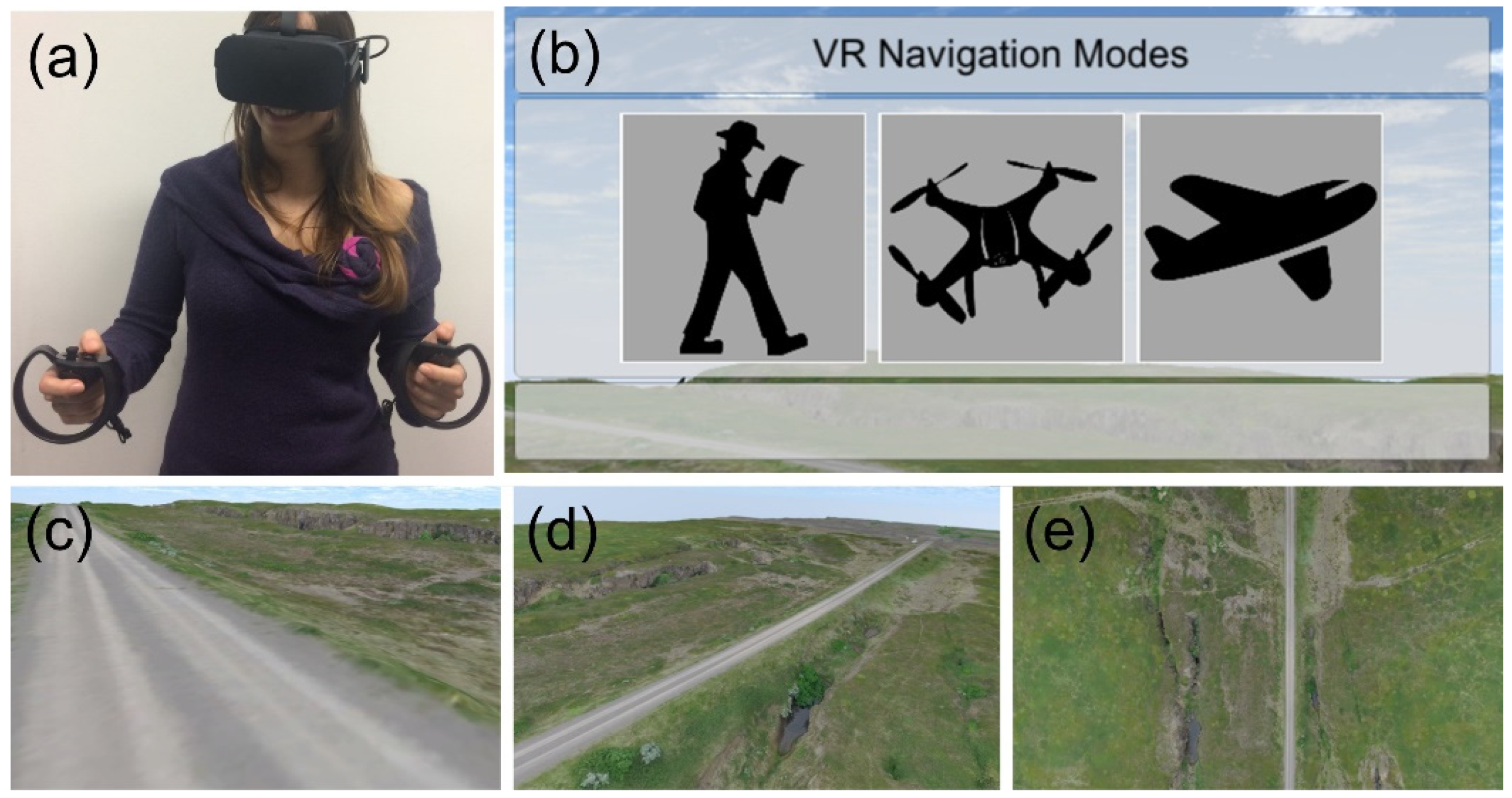
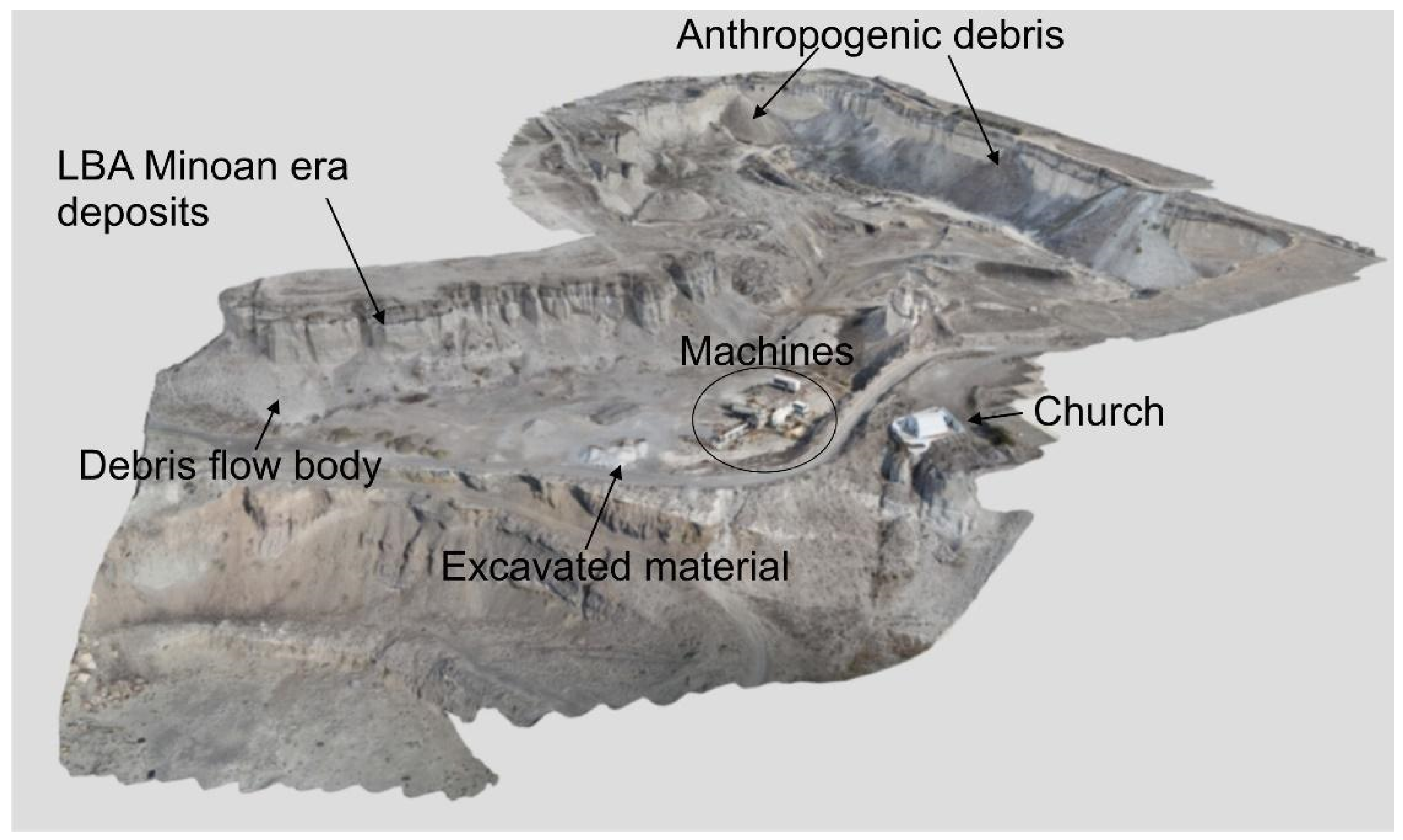


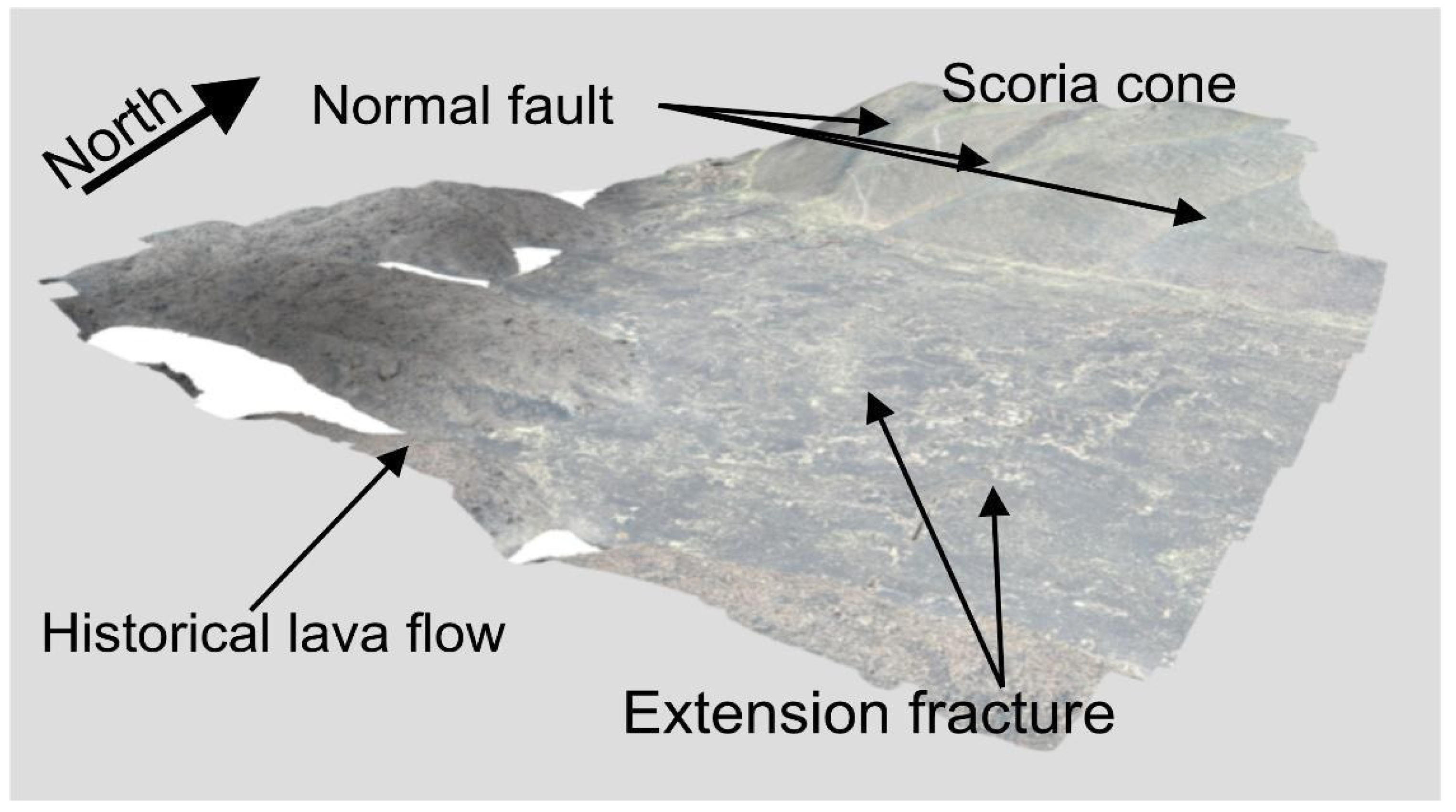

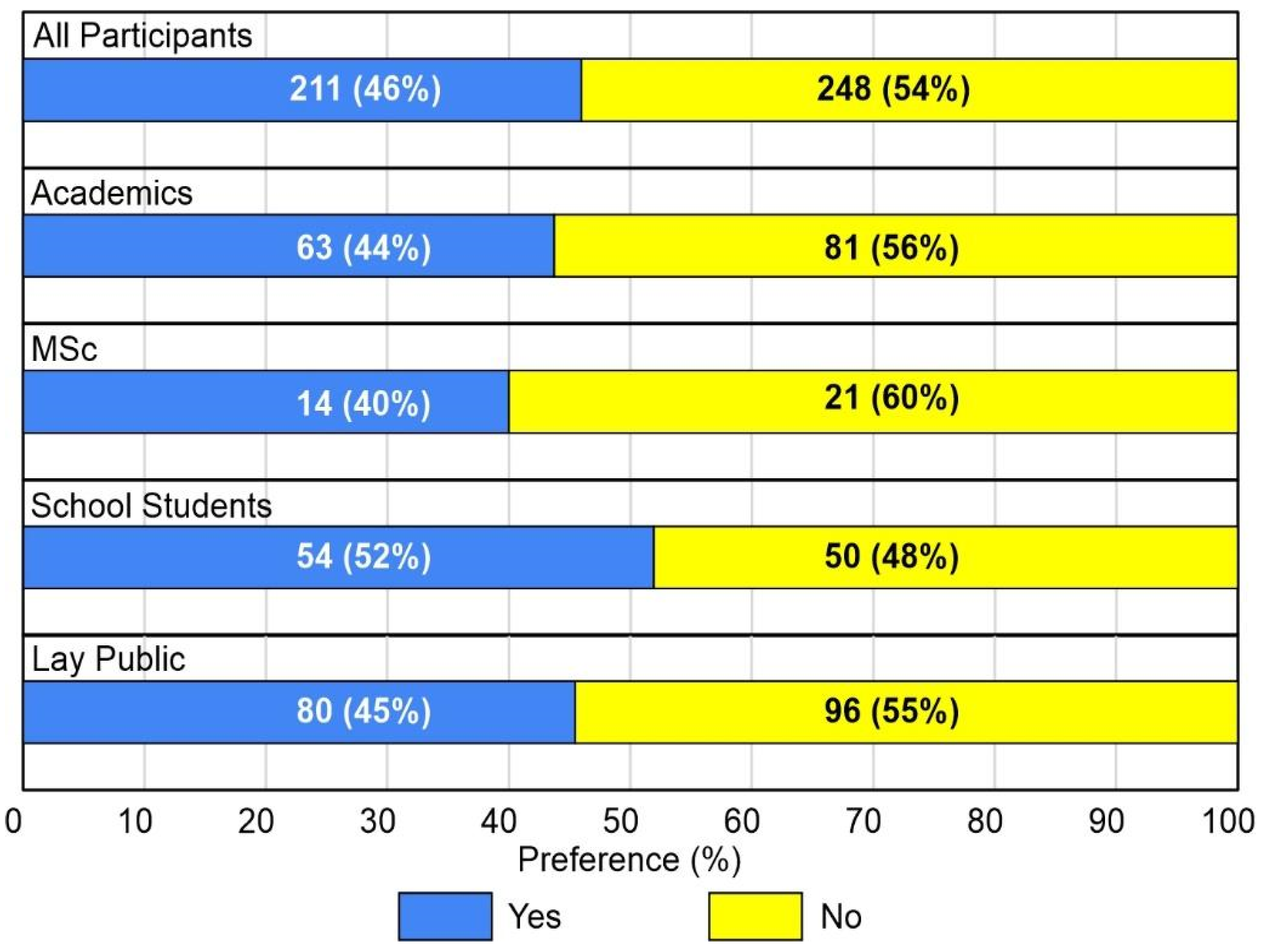


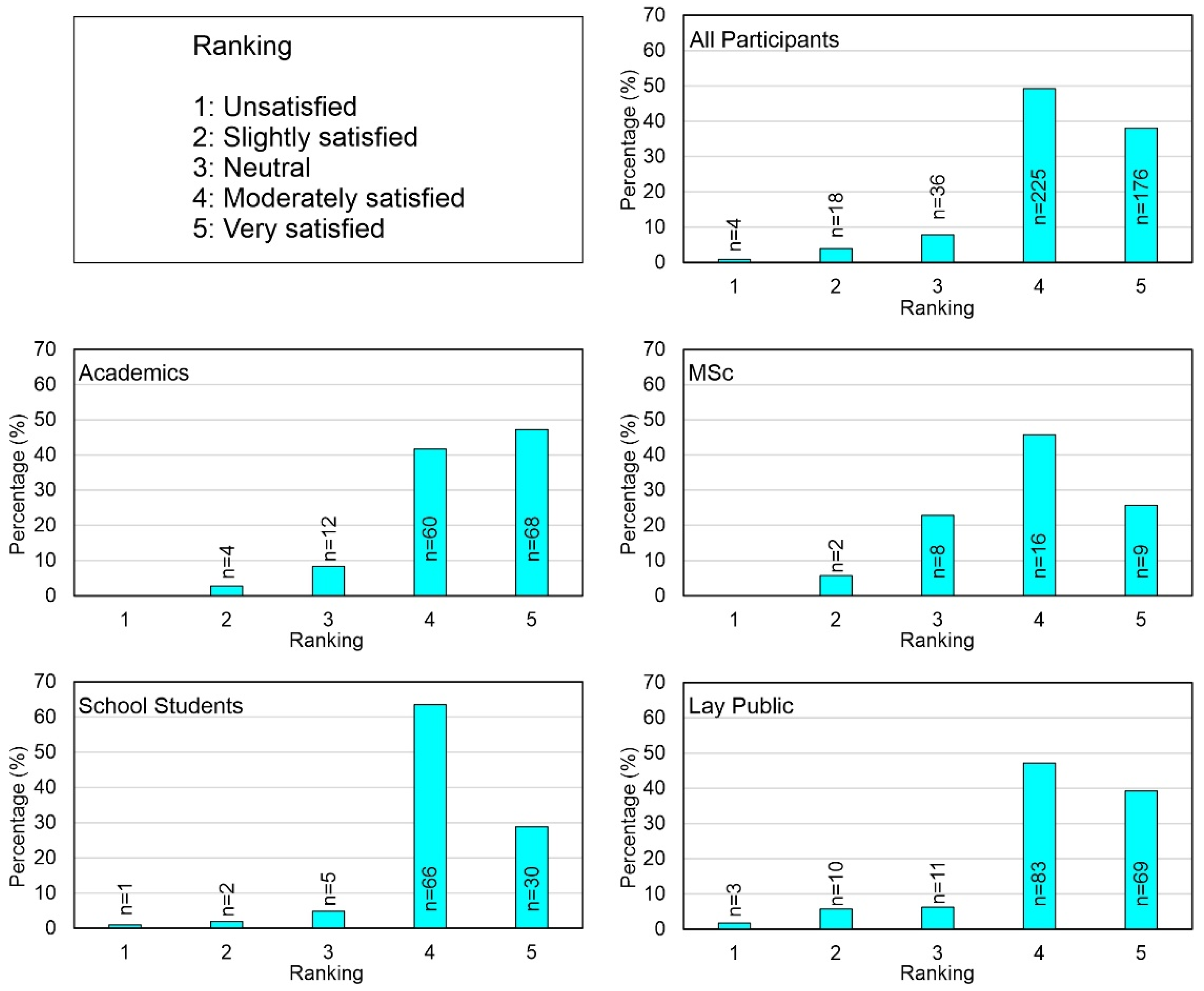

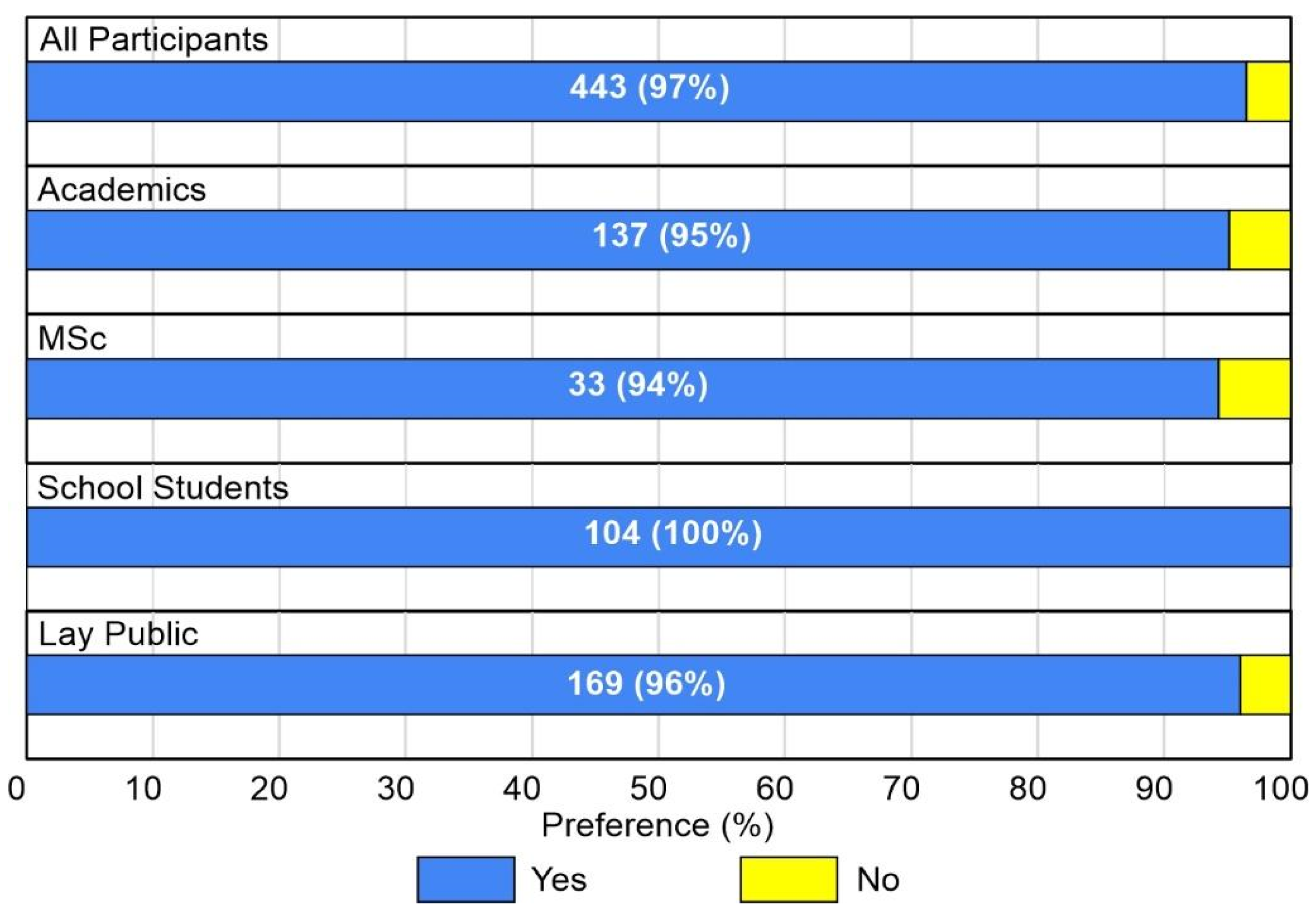
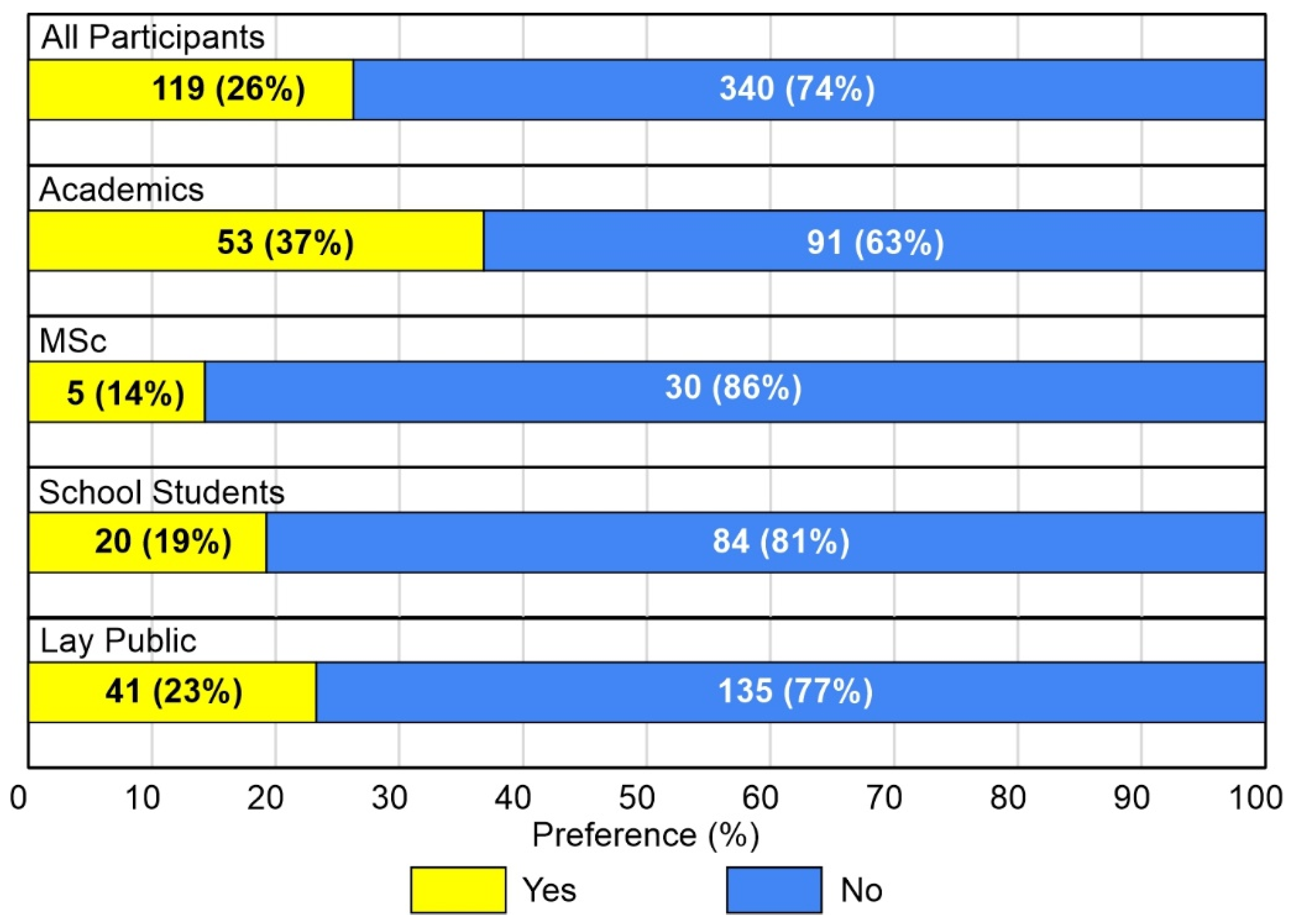
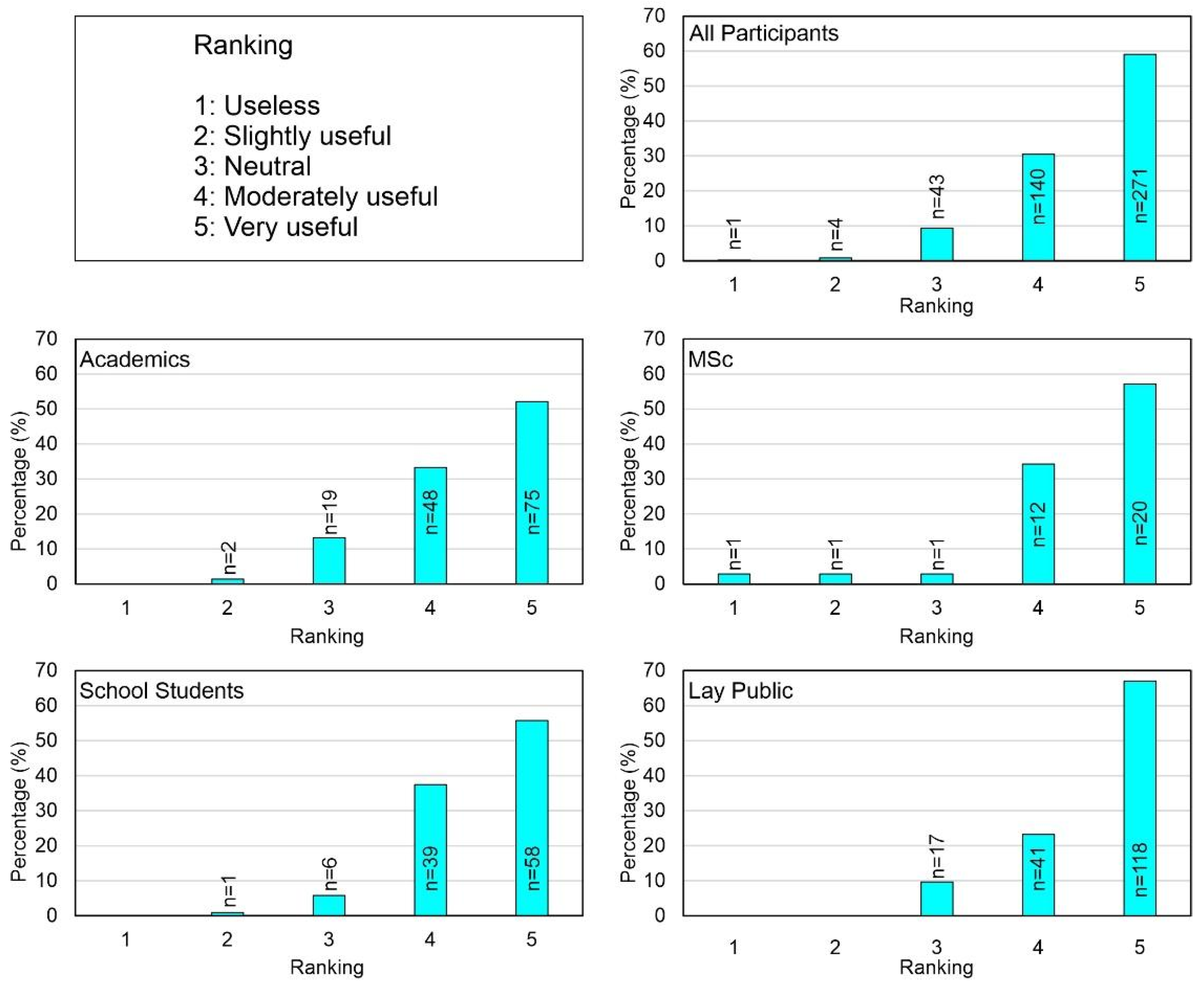

Publisher’s Note: MDPI stays neutral with regard to jurisdictional claims in published maps and institutional affiliations. |
© 2021 by the authors. Licensee MDPI, Basel, Switzerland. This article is an open access article distributed under the terms and conditions of the Creative Commons Attribution (CC BY) license (https://creativecommons.org/licenses/by/4.0/).
Share and Cite
Bonali, F.L.; Russo, E.; Vitello, F.; Antoniou, V.; Marchese, F.; Fallati, L.; Bracchi, V.; Corti, N.; Savini, A.; Whitworth, M.; et al. How Academics and the Public Experienced Immersive Virtual Reality for Geo-Education. Geosciences 2022, 12, 9. https://doi.org/10.3390/geosciences12010009
Bonali FL, Russo E, Vitello F, Antoniou V, Marchese F, Fallati L, Bracchi V, Corti N, Savini A, Whitworth M, et al. How Academics and the Public Experienced Immersive Virtual Reality for Geo-Education. Geosciences. 2022; 12(1):9. https://doi.org/10.3390/geosciences12010009
Chicago/Turabian StyleBonali, Fabio L., Elena Russo, Fabio Vitello, Varvara Antoniou, Fabio Marchese, Luca Fallati, Valentina Bracchi, Noemi Corti, Alessandra Savini, Malcolm Whitworth, and et al. 2022. "How Academics and the Public Experienced Immersive Virtual Reality for Geo-Education" Geosciences 12, no. 1: 9. https://doi.org/10.3390/geosciences12010009
APA StyleBonali, F. L., Russo, E., Vitello, F., Antoniou, V., Marchese, F., Fallati, L., Bracchi, V., Corti, N., Savini, A., Whitworth, M., Drymoni, K., Mariotto, F. P., Nomikou, P., Sciacca, E., Bressan, S., Falsaperla, S., Reitano, D., van Wyk de Vries, B., Krokos, M., ... Tibaldi, A. (2022). How Academics and the Public Experienced Immersive Virtual Reality for Geo-Education. Geosciences, 12(1), 9. https://doi.org/10.3390/geosciences12010009

















